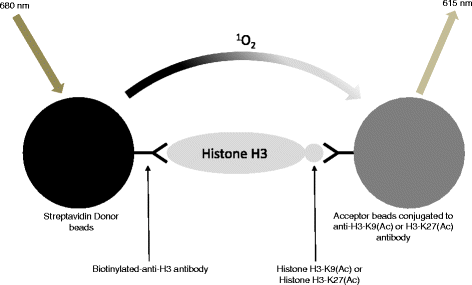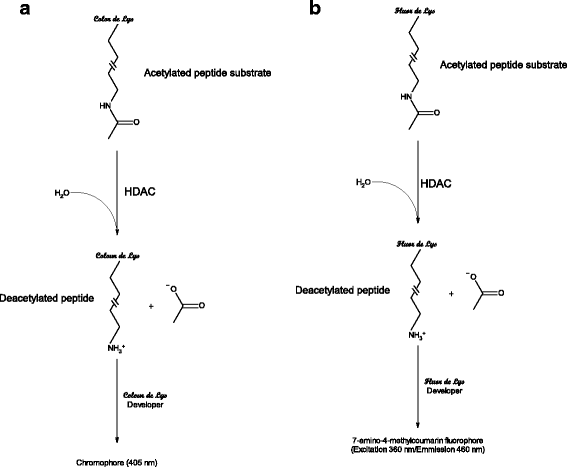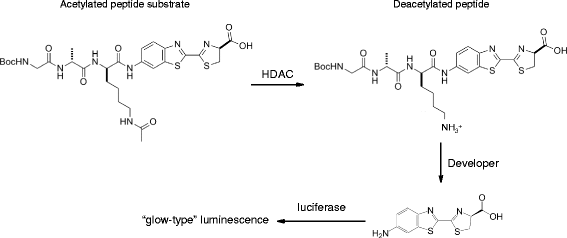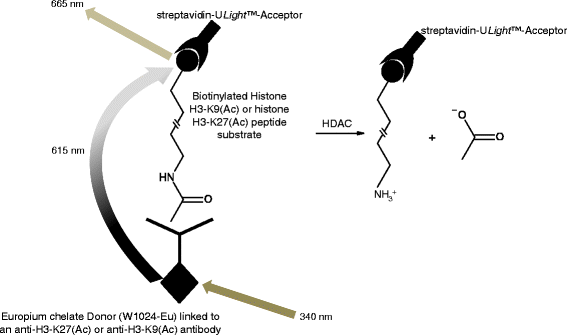Epigenetic assays for chemical biology and drug discovery
- PMID: 28439316
- PMCID: PMC5399855
- DOI: 10.1186/s13148-017-0342-6
Epigenetic assays for chemical biology and drug discovery
Abstract
The implication of epigenetic abnormalities in many diseases and the approval of a number of compounds that modulate specific epigenetic targets in a therapeutically relevant manner in cancer specifically confirms that some of these targets are druggable by small molecules. Furthermore, a number of compounds are currently in clinical trials for other diseases including cardiovascular, neurological and metabolic disorders. Despite these advances, the approved treatments for cancer only extend progression-free survival for a relatively short time and being associated with significant side effects. The current clinical trials involving the next generation of epigenetic drugs may address the disadvantages of the currently approved epigenetic drugs. The identification of chemical starting points of many drugs often makes use of screening in vitro assays against libraries of synthetic or natural products. These assays can be biochemical (using purified protein) or cell-based (using for example, genetically modified, cancer cell lines or primary cells) and performed in microtiter plates, thus enabling a large number of samples to be tested. A considerable number of such assays are available to monitor epigenetic target activity, and this review provides an overview of drug discovery and chemical biology and describes assays that monitor activities of histone deacetylase, lysine-specific demethylase, histone methyltransferase, histone acetyltransferase and bromodomain. It is of critical importance that an appropriate assay is developed and comprehensively validated for a given drug target prior to screening in order to improve the probability of the compound progressing in the drug discovery value chain.
Keywords: Assay development; Bromodomain; Chemical biology; Chemical probe; Demethylase; Drug discovery; High throughput screening; Histone acetyltransferase; Histone deacetylase; Histone methyltransferase.
Figures




Similar articles
-
Perspectives on the discovery of small-molecule modulators for epigenetic processes.J Biomol Screen. 2012 Jun;17(5):555-71. doi: 10.1177/1087057112437763. Epub 2012 Mar 5. J Biomol Screen. 2012. PMID: 22392809 Review.
-
Development of homogeneous nonradioactive methyltransferase and demethylase assays targeting histone H3 lysine 4.J Biomol Screen. 2012 Jan;17(1):49-58. doi: 10.1177/1087057111416659. Epub 2011 Sep 21. J Biomol Screen. 2012. PMID: 21940714
-
Successful strategies in the discovery of small-molecule epigenetic modulators with anticancer potential.Future Med Chem. 2015;7(16):2243-61. doi: 10.4155/fmc.15.140. Epub 2015 Oct 29. Future Med Chem. 2015. PMID: 26510529 Review.
-
Screening Library Design.Methods Enzymol. 2018;610:73-96. doi: 10.1016/bs.mie.2018.09.016. Epub 2018 Oct 19. Methods Enzymol. 2018. PMID: 30390806
-
High-throughput screening with nucleosome substrate identifies small-molecule inhibitors of the human histone lysine methyltransferase NSD2.J Biol Chem. 2018 Aug 31;293(35):13750-13765. doi: 10.1074/jbc.RA118.004274. Epub 2018 Jun 26. J Biol Chem. 2018. PMID: 29945974 Free PMC article.
Cited by
-
The timeline of epigenetic drug discovery: from reality to dreams.Clin Epigenetics. 2019 Dec 2;11(1):174. doi: 10.1186/s13148-019-0776-0. Clin Epigenetics. 2019. PMID: 31791394 Free PMC article. Review.
-
Integration of Epigenetic Mechanisms into Non-Genotoxic Carcinogenicity Hazard Assessment: Focus on DNA Methylation and Histone Modifications.Int J Mol Sci. 2021 Oct 11;22(20):10969. doi: 10.3390/ijms222010969. Int J Mol Sci. 2021. PMID: 34681626 Free PMC article. Review.
-
A Computational Approach for the Discovery of Novel DNA Methyltransferase Inhibitors.Curr Issues Mol Biol. 2024 Apr 16;46(4):3394-3407. doi: 10.3390/cimb46040213. Curr Issues Mol Biol. 2024. PMID: 38666943 Free PMC article.
-
Investigations on small molecule inhibitors targeting the histone H3K4 tri-methyllysine binding PHD-finger of JmjC histone demethylases.Bioorg Med Chem. 2018 Jul 15;26(11):2984-2991. doi: 10.1016/j.bmc.2018.03.030. Epub 2018 Mar 19. Bioorg Med Chem. 2018. PMID: 29764755 Free PMC article. Review.
-
Development of novel benzamide class I selective lysine deacetylase inhibitors as potent anticancer agents.J Enzyme Inhib Med Chem. 2025 Dec;40(1):2520612. doi: 10.1080/14756366.2025.2520612. Epub 2025 Jul 1. J Enzyme Inhib Med Chem. 2025. PMID: 40590424 Free PMC article.
References
Publication types
MeSH terms
Substances
LinkOut - more resources
Full Text Sources
Other Literature Sources

